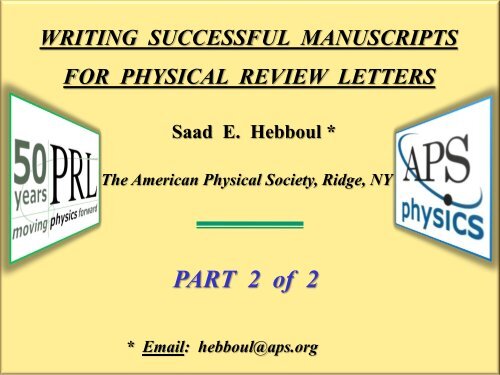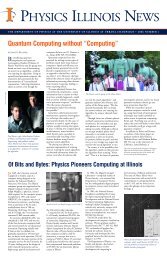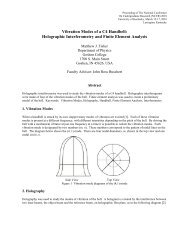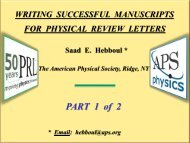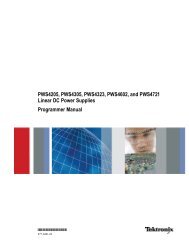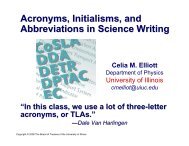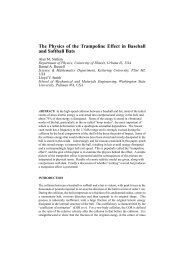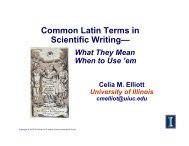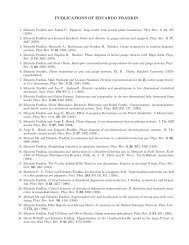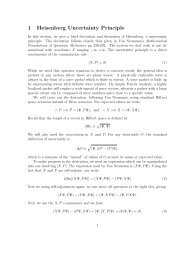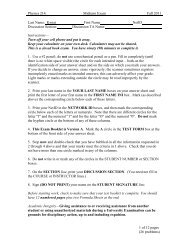Dr. Hebboul's PRL Workshop Part 2 slides
Dr. Hebboul's PRL Workshop Part 2 slides
Dr. Hebboul's PRL Workshop Part 2 slides
You also want an ePaper? Increase the reach of your titles
YUMPU automatically turns print PDFs into web optimized ePapers that Google loves.
WRITING SUCCESSFUL MANUSCRIPTSFOR PHYSICAL REVIEW LETTERSSaad E. Hebboul *The American Physical Society, Ridge, NYPART 2 of 2* Email: hebboul@aps.org
OUTLINE : PART 2 of 2INACCESSIBLE TEST MANUSCRIPT 1 : LM1ACCESSIBLE TEST MANUSCRIPT 2 : LM2TEST QUESTIONS & PROBLEMS
TEST MANUSCRIPT 1 : LM1Select a LETTER in your field, published after 1990,with 3 overlapping characteristics :DIFFICULT TO READHARD TO GRASP RESULTLESS SURPRISING RESULTLM1 = INACCESSIBLE MANUSCRIPT
TEST MANUSCRIPT 1 : LM1Study the contents of test manuscript LM1 in eachof 3 overlapping categories :ABBREVIATIONS & TERMINOLOGYINTRODUCTION & CONCLUSIONFIVE LEVELS OF THE LAYERED STRUCTURE
TEST MANUSCRIPT 1 : LM1Study the contents of test manuscript LM1 in eachof the 5 levels of the layered structure:FIVE LEVELS OF THE LAYERED STRUCTURETITLEABSTRACTIN THIS LETTERFIGURES & EQUATIONSMAIN TEXTANSWER TEST QUESTIONS FOR LM1
OUTLINE : PART 2 of 2INACCESSIBLE TEST MANUSCRIPT 1 : LM1ACCESSIBLE TEST MANUSCRIPT 2 : LM2TEST QUESTIONS & PROBLEMS
TEST MANUSCRIPT 2 : LM2Select a LETTER in your field, published after 1990,with 3 overlapping characteristics :SIMPLE TO READEASY TO GRASP RESULTMORE SURPRISING RESULTLM2 = ACCESSIBLE MANUSCRIPT
TEST MANUSCRIPT 2 : LM2Study the contents of test manuscript LM2 in eachof the 5 levels of the layered structure:FIVE LEVELS OF THE LAYERED STRUCTURETITLEABSTRACTIN THIS LETTERFIGURES & EQUATIONSMAIN TEXTANSWER TEST QUESTIONS FOR LM2
OUTLINE : PART 2 of 2INACCESSIBLE TEST MANUSCRIPT 1 : LM1ACCESSIBLE TEST MANUSCRIPT 2 : LM2TEST QUESTIONS & PROBLEMS
TEST QUESTIONS & PROBLEMS : LM1 vs. LM2Grade the contents of each test manuscript usinga 200 – point scale divided among 4 problem sets:ABBREVIATIONS & TERMINOLOGY TESTS [ 20 points ]INTRODUCTION & CONCLUSION TESTS [ 40 points ]SELF – SIMILARITY TEST [ 100 points ]WORD CLOUD TEST [ 40 points ]MAXIMUM SCORE = 200 POINTS / MANUSCRIPT
ABBREVIATIONS & TERMINOLOGY TESTS[ 20 points ]ABBREVIATIONS :[ 10 points ]Count the number “ N ” of different types of abbreviations that appear inthe test manuscript. Do not keep track of how often each abbreviation ismentioned in the text.Example abbreviations include AFM, STM, DFT, ARPES, BCS, QD,SWCNT, SDW, among others. Do not count international standards,e.g., chemical compound formulas, units, and math symbols.Award points “ P ” according to the following formula:P = 10 – ( 2 * N ), for N ≤ 5, and P = 0, for N > 5.Example: P = 6 points for N = 2.
ABBREVIATIONS & TERMINOLOGY TESTS[ 20 points ]AUTHOR–NAME TERMINOLOGY :[ 10 points ]Count the number “ N ” of different author-name terminologies thatappear in the test manuscript. Do not keep track of how often eachterminology is mentioned in the text.Example author-name terminologies include the “ Faraday Effect ” andthe “ Bardeen-Cooper-Schrieffer Theory ” . Do not count internationalstandards, e.g., Newton, Coulomb, and Tesla units.Award points “ P ” according to the following formula:P = 10 – ( 2 * N ), for N ≤ 5, and P = 0, for N > 5.Example: P = 2 points for N = 4.
INTRODUCTION & CONCLUSION TESTSINTRODUCTION :[ 30 points ][ 40 points ]Estimate the deviation angle “ δ ” between the manuscriptintroduction “ I ” and an ideal story-line introduction :“ Is ≡ { SURVEY, MOTIVATION, IN THIS LETTER } ”.IδIsSURVEY : Explains the central issue of the work in the context of priorworldwide research accomplishments in the field.MOTIVATION : Identifies the missing link between old & new results.IN THIS LETTER : Presents the new result in relation to previous work.Award points “ P ” according to the following scheme:P = 30, 15, or 0 points for δ = Small, Medium, or Large angles.Example: P = 0 points for a missing SURVEY in the introduction.
INTRODUCTION & CONCLUSION TESTSCONCLUSION :[ 10 points ][ 40 points ]Estimate the deviation angle “ δ ” between the manuscriptconclusion “ C ” and an ideal Tree-Model-type conclusion :“ Ct ≡ { Future BRANCHES, IMPACT, FRUITS } ”.CδCtFuture BRANCHES : Which neighboring fields will be affected by thenew result ? Will the new result generate new fields ?Future IMPACT : What impact will the new result have on these fields ?Future FRUITS : Will the new result give new basic or applied results ?Award points “ P ” according to the following scheme:P = 10, 5, or 0 points for δ = Small, Medium, or Large angles.Example: P = 0 points for summarizing or rewriting the ABSTRACT.
TITLE :SELF – SIMILARITY TEST[ 5 points ][ 100 points ]Estimate the deviation angle “ δ ” between the manuscripttitle “ T ” and an ideal specific result-oriented title :“ Tr ≡ { ACCURATE, ACCESSIBLE, INFORMATIVE } ”.TδTrACCURATE : Represents the new experimental and/or theoretical resultaccurately. Contains physical/chemical system(s) with the new result.ACCESSIBLE : Avoids jargon, new terminology, & language problems.INFORMATIVE : Invokes a clear new result or idea in the reader’s mind.Award points “ P ” according to the following scheme:P = 5, 3, or 0 points for δ = Small, Medium, or Large angles.Example: P = 0 points for “ Transport properties of superconductors ”.
SELF – SIMILARITY TESTABSTRACT :[ 10 points ][ 100 points ]Estimate the deviation angle “ δ ” between the manuscriptabstract “ A ” and an ideal result-summarizing abstract :“ Ar ≡ { ACCURATE, ACCESSIBLE, No-BACKGROUND } ”.AδArACCURATE : Summarizes the new experimental and/or theoretical resultaccurately. Contains method(s) and means for obtaining the new result.ACCESSIBLE : Avoids jargon, new terminology, & language problems.No-BACKGROUND : Avoids introductory material including references.Award points “ P ” according to the following scheme:P = 10, 5, or 0 points for δ = Small, Medium, or Large angles.Example: P = 0 points for abstract with historical account and/or jargon.
SELF – SIMILARITY TESTIN THIS LETTER :[ 15 points ][ 100 points ]Estimate the deviation angle “ δ ” between the introductionending “ I ” and an ideal “ In This Letter ” result presentation :“ Ir ≡ { COMPLETE, DETAILED, FULL - STORY } ”.IδIrCOMPLETE : Presents the new experimental and/or theoretical result inits entirety. Contains specific method(s) for obtaining the new result.DETAILED : Gives enough detail for new method(s) and technique(s).FULL - STORY : Ends the introduction with a “ punch-line ” effect.Award points “ P ” according to the following scheme:P = 15, 10, or 5 points for δ = Small, Medium, or Large angles.Example: P = 5 points for “ In this Letter, we solve this old problem. ”.
SELF – SIMILARITY TEST[ 100 points ]FIGURES & EQUATIONS :[ 30 points ]Estimate the deviation angle “ δ ” between the figures and/orequations “ F ” and an ideal graphical/symbolic representation :“ Fr ≡ { SETUP, DATA, EQUATIONS, ANALYSIS } ”.FδFrSETUP : Defines the full physical/chemical/biological system(s) studied.DATA : Shows raw measurements, data, and/or model assumptions.EQUATIONS : Derives the essential symbolic formulation for the model.ANALYSIS : Adds physical significance to raw data and/or calculations.Award points “ P ” according to the following scheme:P = 30, 15, or 5 points for δ = Small, Medium, or Large angles.Example: P = 15 points for data-plot figures without a SETUP in Fig.1.
SELF – SIMILARITY TESTMAIN TEXT :[ 40 points ][ 100 points ]Estimate the deviation angle “ δ ” between the main text “ M ”and an ideal technical presentation of the result and analysis :“ Mr ≡ { EXPERIMENT, THEORY, RESULT, DISCUSSION } ”.EXPERIMENT : Describes the full experimental setup and techniques.THEORY : Describes the full theoretical idea and model assumptions.RESULT : Presents the entire result in enough detail for others to verify.DISCUSSION : Analyzes the result. Reveals its strengths and limitations.Award points “ P ” according to the following scheme:P = 40, 20, or 10 points for δ = Small, Medium, or Large angles.Example: P = 20 points for NO description of how the result is obtained.MδMr
WORD CLOUD TEST[ 40 points ]Download a text file version of the test Letter. See the last slide for instructions.Generate a word cloud at “ wordle.net ” as shown below. The size of each wordin the cloud reflects how often that word appears in the text file.WORD CLOUDS WEBSITE : www.wordle.net
WORD CLOUD TEST[ 40 points ]MOST FREQUENT VERBS :[ 20 points ]Record the five most frequent verbs in the test manuscript.These are the largest verbs in the word cloud. Form a vector“ V ” whose components are the five verbs in order of decreasingsize or frequency.VδVrEstimate the deviation angle “ δ ” between the verb vector “ V ” of the testmanuscript and an ideal strong verb vector for important results :“ Vr ≡ { FIND, SHOW, DEMONSTRATE, DISCOVER, PREDICT } ”.Award points “ P ” according to the following scheme:P = 20, 10, or 5 points for δ = Small, Medium, or Large angles.Example: P = 5 points for the following vector of weak-Letter verbs :“ V ≡ { STUDY, INVESTIGATE, SEARCH, VERIFY, REVISIT } ”.
WORD CLOUD TEST[ 40 points ]MOST FREQUENT NON - VERBS :[ 20 points ]Record the five most frequent non-verb words in the testmanuscript. These are the largest non-verbs in the word cloud.Form a vector “ N ” whose components are the five non-verbsin order of decreasing size or frequency.NδNrEstimate the deviation angle “ δ ” between the non-verb vector “ N ” of thetest manuscript and one possible non-verb vector for important results :“ Nr ≡ { RESULT, EVIDENCE, SOLUTION, DATA, PEAK } ”.Award points “ P ” according to the following scheme:P = 20, 10, or 5 points for δ = Small, Medium, or Large angles.Example: P = 5 points for the following vector of specialized non-verbs :“ N ≡ { CONTROL, AMPLIFIER, dB, CODE, dI/dV } ”.
SCORECONCLUSIONS : PART 2 of 2INACCESSIBLE TEST MANUSCRIPT 1 : LM1Tends to score LOW on the 200 – point test.Will likely have LOW impact on neighboring fields.ACCESSIBLE TEST MANUSCRIPT 2 : LM2Tends to score HIGH on the 200 – point test.Will likely have HIGH impact on neighboring fields.TEST QUESTIONS & PROBLEMS :The 200 – point test canidentify the transitionfrom ROUGH drafts toPOLISHED manuscripts.ROUGHDRAFT NUMBERPOLISHED
ADDITIONAL PROBLEMS[ Extra Credit ]The next 3 problems ask you to enter your proposed revisions in the textfileversions of test manuscripts LM1 and LM2.Can you expand all word abbreviations & acronyms in LM1and LM2 without increasing the length of the affected sentences ?Hint : <strong>Dr</strong>aw a path diagram for the sentence. Identify and removeall secondary ideas in side branches. Create a concise version of thesentence that preserves the central meaning without abbreviations.Can you find suitable scientific phrases as substitutes for all effectsthat are named after their discoverers in both LM1 and LM2 ?A suitable phrase should be no more than 4 words long.Example : “ Faraday Effect ” “ Magnetooptical Effect ”Can you rework the introductions of LM1 and LM2 so that theirsurvey, motivation, and In-this-Letter parts are clearly separatedin 3 consecutive paragraphs ? Can you improve the conclusionsof LM1 and LM2 if they fail to go beyond a summary of results ?
DOWNLOADING TEXT – FILE LETTERSFOR WORD – CLOUD TESTSAccess the selected published Letter online at the <strong>PRL</strong> website.From the web browser, e.g., Firefox, click on “Save Page As”,then save the Letter as an “Adobe Acrobat Document”.Open the saved file in “Adobe Reader” by double-clickingon the filename.From “Adobe Reader”, click on “File”, then “Save As”,then “Text”.Save a text version of the Letter in a text file. Make sure thespacing between successive words is not lost in the conversion.Remove all formatting symbols and delete the reference list.Keep all equations, math symbols, and other text symbols.
DISCLAIMERThe material in this workshop is meant to help authorswrite “successful” manuscripts that are accessible to abroad readership. While a “successful” manuscriptmight make a better case for a Letter, there is noguarantee that <strong>PRL</strong> will accept it. The relative merit ofeach manuscript is based on the validity, importance,and broad interest of the reported result. This workshopis primarily aimed at improving the presentation whichplays a key role.Aside from the list of 100 specialized terminologies, noother part of this workshop is obtained from existingmanuscripts. Any similarity with published Letters orreviewed manuscripts is pure coincidence. Do not copytext from edited Letters in your own manuscripts.


